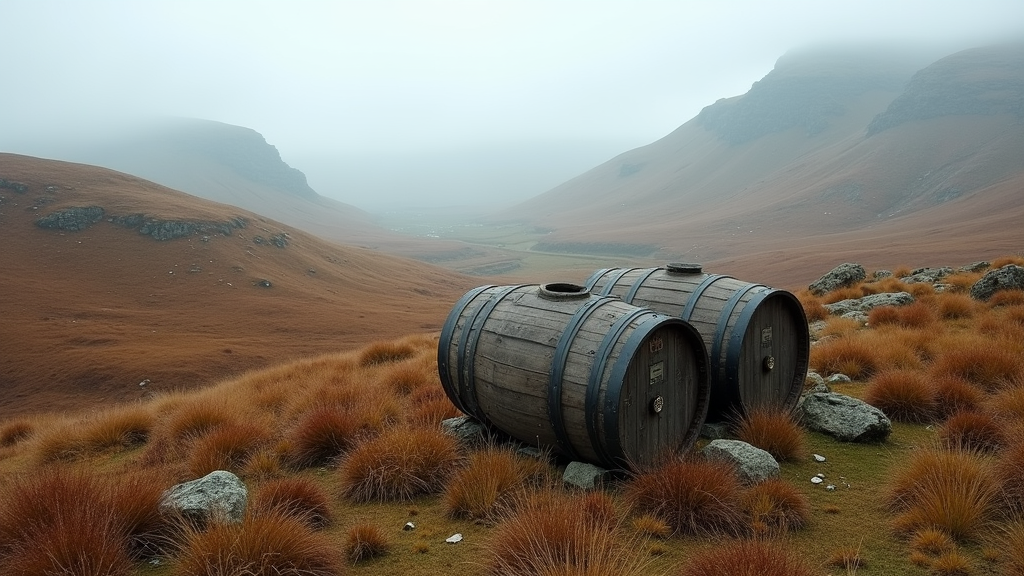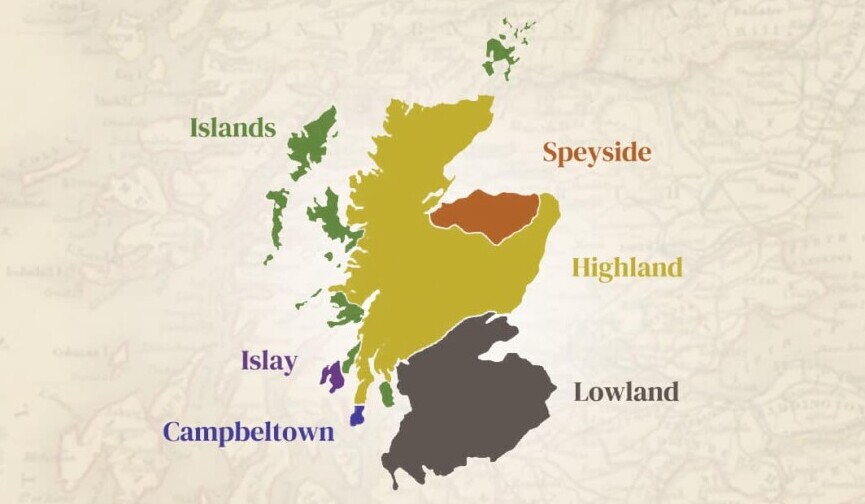Scotch whisky is more than just a drink; it is an adventure through history, geography, and time. I have always found Scotland’s rich tapestry reflected in its whisky. Every bottle tells stories of ancient landscapes and time-honored techniques that have been passed down through generations. The craft embodies not only tradition but also creativity and innovation, making each dram a unique experience filled with character and passion.
This article explores the five major regions for Scotch whisky, providing an all-in-one look at their distinct differences. Scotch whisky is one of several different whiskey types. I will explain key variations in flavor, production methods, and even the challenges faced by distillers across Scotland. With careful observation of regional style and tradition, you can gain a clearer sense of what sets these regions apart. This exploration invites both newcomers and connoisseurs to appreciate the intricate details behind every sip.

Table of Contents
- Overview of Scotch Whisky Regions
- Understanding the Characteristics of Each Region
- A Closer Look at the Five Regions
- Common Factors Influencing Scotch Whisky Production
- Tips for New Scotch Whisky Enthusiasts
- Frequently Asked Questions about Scotch Whisky Regions
- Final Thoughts
Overview of Scotch Whisky Regions
Scotch whisky is divided into five main regions, each exhibiting its own style and personality. The differences in climate, water sources, malt types, and production methods work together to create the distinct characteristics found in each area. The five regions are Speyside, Islay, Highlands, Lowlands, and Campbeltown. This clear division underlines Scotland’s geographical diversity while celebrating the skill and dedication of master distillers who have refined their art over centuries.
When I consider the regional differences, it becomes apparent why whisky fans often develop personal favorites. Some regions produce smoother, sweeter drams while others offer a bolder, smokier experience. Whether your preference leans toward lush, fruity profiles or you are drawn to intense, maritime influences, there is a Scotch whisky crafted to suit every palate. This overview sets the stage for a deeper understanding of what each region contributes to the world of whisky.
Understanding the Characteristics of Each Region
Local conditions and historical practices shape the profiles of Scotch whiskies in distinctive ways. Factors such as regional climate, the quality of available water, and unique malting procedures significantly affect the final taste. Whether it is the influence of a rugged coastal environment or the soft, inland waters, every detail matters in creating the whisky’s character.
For instance, coastal distilleries are often touched by salted sea breezes and rugged terrain, contributing to a slightly briny and smoky flavor. In contrast, inland distilleries tend to produce whiskies with milder and sometimes sweeter notes. Recognizing these characteristics offers valuable insight into how nature and craft come together to shape each bottle.
A Closer Look at the Five Regions
Below is a detailed yet concise look at each Scotch whisky region along with their signature flavor profiles, brands (Some of my favorites are linked) production styles:
- Speyside: Renowned for its sweet and fruity notes, Speyside whiskies often feature aromas of apple, pear, and honey with subtle hints of vanilla and oak. These drams tend to be elegant and smooth, making them easily approachable. Prominent brands from this region include Glenfiddich, The Glenlivet, and Macallan. Their refined flavors highlight the delicate balance achieved through meticulous production techniques.
- Islay: Islay is famous for its intense, smoky character, stemming largely from heavy peat use. The island’s maritime nature introduces touches of seaweed and iodine, often with an edge of medicinal sharpness. Iconic names like Laphroaig, Ardbeg, and Lagavulin exemplify this bold style. The raw, unfiltered expressions from Islay capture the rugged spirit of the island perfectly.
- Highland: Spanning a vast and varied area, the Highlands produce whiskies ranging from lightly floral and fruity to robust and subtly peated. These drams combine malt, heather, and spice in a balanced manner that caters to diverse tastes. Notable distilleries such as Oban, Glenmorangie, and Dalmore offer a range of profiles that mirror the region’s wide-ranging landscapes.
- Lowland: Known for their lighter, more delicate style, Lowland whiskies are typically triple distilled. They present a clean, fresh nose with gentle floral and citrus notes, punctuated by modest spices. Brands like Auchentoshan and Glenkinchie stand out for their crisp and refined character, making them ideal for those who appreciate subtle complexities.
- Campbeltown: Once a hub of whisky production, Campbeltown now produces drams celebrated for their unique complexity. These whiskies often balance a hint of peat, maritime saltiness, and dried fruit nuances with a touch of smoke. Distilleries such as Springbank and Glen Scotia lead this category, offering a distinct expression that reflects the region’s storied past.
The distinctions between these regions highlight how variations in water, barley, and aging can create an array of taste experiences. This structured snapshot provides a clear picture of what to expect from each area, allowing whisky enthusiasts to navigate their choices with informed confidence.

Common Factors Influencing Scotch Whisky Production
Several key factors influence the production process of Scotch whisky. A careful study of these elements reveals why whiskies can differ so greatly in quality and flavor. The environment plays a critical role, with factors such as climate, water quality, and malt selection being very important. Distillers rely on traditional methods while also embracing creative approaches to bring out the best in their spirit.
Climate, for instance, affects how the whisky matures in the cask. Regions with cooler temperatures see a slower aging process, resulting in a more delicate flavor development. Warmer climates, on the other hand, can speed up the interaction between the spirit and the wood, leading to richer, deeper notes. Water quality is equally significant—while inland regions benefit from soft, pure water, coastal areas incorporate mineral-rich influences into their profiles.
Furthermore, the process of drying malt over peat fires plays a decisive role in imparting smoky flavors. Even minor variations in this stage can lead to noticeable differences in the final product. By understanding these factors, one can appreciate the intricate balance that goes into creating each unique Scotch whisky.
Tips for New Scotch Whisky Enthusiasts
If you are just beginning to explore the world of Scotch whisky, here are some practical tips based on sincere personal experience. First, start with a region that aligns with your taste preferences. For those who lean toward richer profiles, the Highlands or Campbeltown may be an excellent starting point. Alternatively, if you prefer lighter or sweeter drams, the Lowlands or Speyside offer accessible introductions that won’t overwhelm your palate.
Tasting small samples is a smart approach. Many bars and specialty shops offer flights, allowing you to try different whiskies without committing to a full bottle. Keeping a small notebook of your impressions regarding aroma, flavor, and finish can help you notice patterns and refine your personal preferences over time. Finally, be curious and willing to experiment. Whisky tasting is a dynamic experience, and with every new dram, you may uncover unexpected nuances that expand your appreciation of the craft.
Frequently Asked Questions about Scotch Whisky Regions
Many questions arise as enthusiasts seek to understand the diversity of Scotch whisky. Here are a few commonly asked questions along with thoughtful answers:
Question: What distinguishes the five major regions?
Answer: Each region is defined by subtle differences in environment and production methods. The resulting flavors can range from the sweet and fruity to the dramatically smoky. Local climate, water sources, and traditional malting techniques all play a very important role in shaping these profiles.
Question: Are there hard boundaries between these regions?
Answer: While the regional classifications serve as a useful guide, the boundaries are often blurred. Some distilleries experiment by borrowing techniques from other regions, creating innovative blends that cross traditional lines and introduce fresh interpretations.
Question: How important is peat in influencing flavor?
Answer: Peat is used in the malting process to impart smoky qualities. This influence is particularly marked in Islay whiskies, where peat smoke plays a starring role. It can also appear to a lesser degree in some Highland and Campbeltown expressions.
Question: What impact does aging have on Scotch whisky?
Answer: Aging in oak casks allows the spirit to gradually evolve, softening rough edges and developing deeper complexity. Different barrel types, whether previously used for bourbon or sherry, contribute unique characteristics over time.
Final Thoughts
My ride into Scotch whisky has revealed that each region offers its own distinct narrative. Knowing the regions—from the smooth, approachable profile of the Lowlands to the bold, smoky essence of Islay—provides a framework for exploring a world rich in tradition and innovation. Understanding these nuances deepens your appreciation of the craft behind every bottle.
Whether you enjoy the refined sweetness of Speyside or the robust complexity found in the Highlands and Campbeltown, there is a whisky waiting to tell its story. Keep experimenting, read about various distilleries, and don’t hesitate to ask questions at tastings or specialty events. These simple practices not only build your knowledge but also help you shape a personal collection that reflects your evolving taste.
Wrapping up, Scotch whisky remains a testament to Scotland’s legacy and the passion of countless artisans. With each sip, you experience a blend of nature, craftsmanship, and history. I trust that as you check out deeper into these regions, you will uncover layers of flavor that mirror Scotland’s rich cultural and natural heritage, leaving you with a lasting admiration for this remarkable spirit.
About Jim
Jim is the creator of Dram Discoveries, a blog dedicated to exploring and celebrating the world of whiskey. With over six years of experience, he combines a passion for whiskey’s craft and culture with a love for connecting enthusiasts through tastings, stories, and shared discoveries. For Jim, whiskey is more than a drink—it’s a journey of camaraderie, learning, and lifelong appreciation.
There are no affiliate links in this post.

-I actually didn’t know that Scotland was divided into regions for whiskey; though it makes a little bit of sense.
-Im not sure that I could get into Islay flavor right away, but it seems like it’s the ultimate goal for a person like me, who prefers deeper flavor even though I’m not against sweetness, either.
-One question I will ask is, does the region actually affect the quality of the whiskey? That is, are there certain resources available in other parts that are not available in previous ones?
-I look forward to a potential response from you; take care,
ALEJANDRO G.
Thanks for your thoughtful comment! You’re right—Scotland’s regions each bring their own character, influenced by local water, peat, and traditions, rather than one region being “better” in quality. The regional differences mostly shape the flavor profiles, so while Islay whiskies tend to be more peaty and robust (and might be an acquired taste), they’re just one of many expressions of Scotch. It’s all about finding the style that suits your palate best. Cheers, and thanks for engaging with the post!
Hello Jim!
This breakdown of the five major Scotch whisky regions is fantastic! It’s amazing how much geography influences the flavors, from the smoky peat of Islay to the delicate notes of the Lowlands.
Do you have a favorite region, or do you enjoy exploring different styles depending on the occasion? Also, how much do you think aging affects the distinct regional characteristics?
Angela M 🙂
Angela,
Thanks so much for your thoughtful comment! I do have a couple of favorite regions—I’m particularly drawn to the Highlands and Speyside for their unique balance and character. While I love exploring different styles depending on the occasion, those two regions often stand out for me. As for aging, I think it really plays a crucial role in rounding out a whisky’s profile. Longer aging can soften some of the more aggressive notes while enhancing the inherent regional characteristics, letting the distinct flavors shine through in a more refined way. Cheers for engaging with the post!
Cheers! Jim